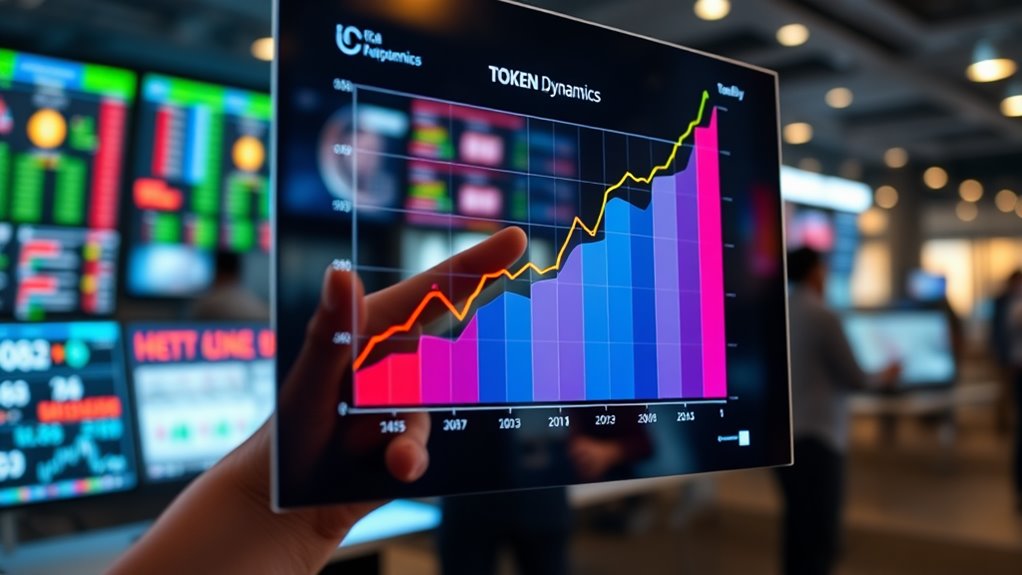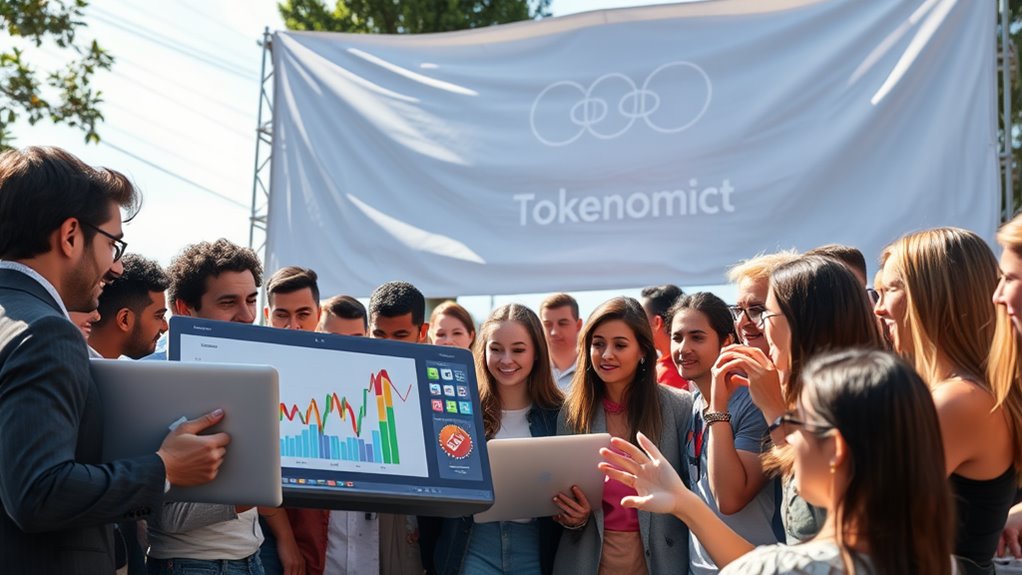
Tokenomics and ICO Valuations: Essential Strategies for Success
Tokenomics and ICO valuations are essential for the success of blockchain projects. Understanding token supply dynamics, such as circulating and total supply, impacts market perception and liquidity. Fair token distribution models enhance trust among investors, while clear token utility drives ecosystem success. Strategies for market stability, including effective vesting schedules, prevent volatility and align stakeholder interests. Community engagement fosters demand and loyalty. Further exploration reveals innovative valuation techniques that assess a token’s market potential and financial health.
Key Takeaways
- Establish clear token supply dynamics and distribution models to enhance investor confidence and stabilize market conditions.
- Implement effective governance structures to ensure community engagement and participation in decision-making processes.
- Utilize comprehensive vesting strategies to prevent sudden market sell-offs and align stakeholder interests with project milestones.
- Apply innovative token valuation techniques, such as MVRV and NVT ratios, to provide insights into project potential and market efficiency.
- Foster transparency in token distribution and fundraising to build trust and enhance long-term investor confidence.
Understanding Token Supply and Its Impact on Value

When examining the dynamics of token supply, it becomes evident that various factors greatly influence a token’s value in the cryptocurrency market. The circulating supply, which includes all tokens available for trading, directly affects market capitalization and liquidity.
Total supply encompasses all existing tokens, while maximum supply sets an absolute cap, influencing scarcity and potential value. A large token supply can lead to lower prices unless demand rises considerably, highlighting the importance of the demand-supply balance.
Developers may manipulate supply through token burning or lockup strategies, impacting market perceptions. Additionally, well-structured tokenomics, including clear pricing mechanisms, can enhance investor confidence and long-term viability, making an understanding of token supply essential for evaluating value in the crypto landscape. Furthermore, different fundraising models like Initial Coin Offerings (ICOs) can significantly affect token supply and investor sentiment.
The Importance of Token Distribution Models

Token distribution models are crucial to the success and sustainability of initial coin offerings (ICOs), as they determine how tokens are allocated among investors, developers, and the community. A well-structured distribution can enhance market stability and foster investor confidence.
Key factors include:
- Fairness: Guarantees equitable access, bolstering trust.
- Scarcity: Controlled distribution prevents flooding the market, impacting price.
- Transparency: Clear communication about allocation maintains credibility.
Effective token distribution strategies can lead to higher success rates and support long-term project viability. Additionally, ensuring that the project adheres to KYC and AML regulations can help mitigate risks and enhance legitimacy.
Well-crafted token distribution strategies significantly enhance success rates and ensure the sustainability of projects in the long run.
By considering regulatory compliance and implementing mechanisms like vesting schedules and lock-up periods, teams can navigate challenges while promoting a healthy ecosystem.
Ultimately, thoughtful distribution models are crucial for establishing a strong foundation for future growth.
Defining Token Utility for Ecosystem Success

In defining token utility, governance rights and transaction fee functions play essential roles in an ecosystem’s success.
Governance rights allow token holders to participate in decision-making, fostering a sense of community and loyalty among users.
Meanwhile, transaction fee functions contribute to the economy by facilitating operations within the ecosystem, ensuring that the platform remains functional and sustainable. Additionally, understanding Token Sales is crucial for investors as it helps them evaluate the potential success of a project.
Governance Rights Importance
How can governance rights shape the success of a blockchain ecosystem? Governance rights play a critical role in determining how decisions are made within a blockchain community.
These rights enable stakeholders to participate actively in the ecosystem, fostering a sense of ownership and responsibility. Effective governance structures can enhance trust and engagement, leading to a more robust ecosystem. A strong governance framework can also ensure compliance with KYC and AML regulations, which is essential for maintaining the project’s credibility and attracting investors.
Key aspects include:
- Inclusive participation: Ensuring all voices are heard promotes fairness.
- Decision-making authority: Clearly defined roles help streamline processes.
- Community engagement: Active involvement strengthens ecosystem bonds.
Transaction Fee Functions
Transaction fees serve a fundamental purpose within blockchain ecosystems, acting as a financial mechanism that supports network health and efficiency. They help prevent network congestion caused by malicious actors, ensuring a smooth transaction process.
Each blockchain has its own fee structure, which can vary based on transaction size, complexity, and overall demand. Fees also incentivize miners or validators to process transactions, maintaining security and operational efficiency.
Some platforms offer fixed fee structures to enhance predictability for users. Low transaction fees can improve scalability, making the ecosystem more accessible and promoting user adoption.
Additionally, well-designed tokenomics can stabilize fees and encourage community engagement, ultimately contributing to the long-term sustainability of blockchain networks. Understanding transaction fee functions is essential for navigating the complexities of crypto exchanges and optimizing user experience.
Strategies for Achieving Market Stability

Effective vesting schedules and strategic token distribution are essential components for achieving market stability.
By implementing vesting periods, projects can prevent sudden sell-offs and align the interests of stakeholders over time.
Additionally, thoughtful token distribution strategies, whether fixed or dynamic, help maintain a predictable supply, thereby reducing volatility and fostering investor confidence. Moreover, addressing regulatory uncertainty can further enhance stability by ensuring compliance with evolving legal frameworks.
Effective Vesting Schedules
When designed thoughtfully, vesting schedules can play an essential role in enhancing market stability within the cryptocurrency ecosystem. By determining the timing and release of tokens, these schedules help prevent market flooding and price volatility.
Effective vesting schedules can include various types, such as linear, cliff, and milestone-based models, each tailored to different project needs. Key benefits include:
- Stabilizing market dynamics by releasing tokens gradually
- Enhancing investor confidence through transparent and secure processes
- Encouraging long-term commitment among stakeholders
Using smart contracts can further automate these processes, ensuring clarity and reducing manipulation risks. Additionally, examining a project’s whitepaper is crucial for understanding how vesting schedules align with the overall vision and tokenomics of the project.
Ultimately, well-structured vesting schedules are fundamental for maintaining a stable and trustworthy market environment, supporting the success of cryptocurrency projects.
Strategic Token Distribution
Strategic token distribution plays an essential role in achieving market stability within the cryptocurrency ecosystem. Allocating tokens wisely is vital; typically, core teams receive 10-30% to align their interests with project success, while community incentives often take 20-40% to promote engagement.
Public sales usually encompass 30-50%, attracting a wider investor base. To maintain fairness, founder and advisor allocations must be balanced. Additionally, burning unsold tokens can enhance value and stability, while careful supply management prevents volatility.
Transparency in distribution builds trust, and active community feedback helps align strategies with investor needs. Overall, a well-planned distribution model fosters stability, ensuring a healthy market environment that supports both project growth and investor confidence. Furthermore, understanding the dynamics of cryptocurrency fundraising is crucial for effectively navigating the complexities of token distribution and maximizing investor engagement.
Designing Effective Vesting Schedules

How can project teams create vesting schedules that truly support their long-term goals? Effective vesting schedules are essential for maintaining market stability and fostering investor confidence. By implementing structured timelines, project teams can prevent market flooding while ensuring that stakeholders remain committed to the project’s success.
Effective vesting schedules are crucial for market stability and long-term stakeholder commitment in any project.
Key considerations include:
- Aligning with project milestones: Tokens should become accessible as milestones are achieved, promoting development.
- Utilizing cliff periods: Initial waiting periods can deter short-term selling and encourage sustained investment.
- Ensuring regulatory compliance: Adhering to legal requirements helps protect the project’s integrity.
Incorporating these elements leads to a well-organized token distribution strategy, ultimately contributing to the sustainable growth and success of the project. Furthermore, effective vesting schedules can enhance investor confidence by demonstrating a commitment to long-term project viability in the evolving landscape of ICOs and IDOs.
Engaging the Community to Drive Demand

Engaging the community is essential for driving demand in any token-based project, as active participation fosters a sense of ownership and commitment among members.
Implementing incentives, such as token rewards for contributions, motivates individuals to engage meaningfully. Governance models that allow decentralized decision-making empower members, increasing their investment in the project’s success.
Organizing community events like hackathons promotes collaboration and innovation, further enhancing engagement. Regular updates and transparency build trust, while feedback loops guarantee that community voices are heard, keeping members informed and involved.
Additionally, partnerships with established entities can improve token utility and visibility, ultimately driving demand. Furthermore, leveraging smart contracts in fundraising can ensure transparency and efficiency, enhancing community confidence in the project.
Collectively, these strategies create a robust community culture, essential for sustainable token growth and market stability.
Innovative Approaches to Token Valuation Techniques

Innovative approaches to token valuation techniques have emerged as essential tools for understanding the complexities of cryptocurrency markets.
These methods provide insights into the financial health and potential of tokens through various analytical frameworks.
- Market Value to Realized Value (MVRV) Ratio: This technique compares market value with realized value, shedding light on market conditions.
- Network Value to Transactions (NVT) Ratio: It evaluates the efficiency of tokens by analyzing their network value against transaction volume.
- Stock-to-Flow Models: These models predict future prices based on token scarcity.
Frequently Asked Questions
How Do Regulatory Changes Affect ICO Token Valuations?
Regulatory changes considerably impact ICO token valuations by altering market sentiment and investor confidence. Stricter regulations may enhance trust, while uncertainties can lead to volatility, ultimately shaping perceptions of legitimacy and risk associated with the tokens.
What Role Do External Market Conditions Play in Token Price Stability?
External market conditions greatly influence token price stability. Factors like market volatility, liquidity, investor sentiment, and regulatory clarity can either enhance or undermine confidence, ultimately impacting price fluctuations and the overall stability of cryptocurrencies.
Can Token Buybacks Impact Long-Term Value Growth?
In the garden of investment, token buybacks act as nourishing rain, fostering growth by reducing supply. Yet, without the sun of project innovation, this rain may yield only fleeting blooms, highlighting the need for holistic strategies.
How Can Investor Sentiment Influence Token Demand?
Investor sentiment greatly influences token demand through emotional responses and social media dynamics. Positive sentiment can drive buying interest, while negative emotions may lead to sell-offs, showcasing the volatile relationship between investor psychology and market performance.
What Are the Best Practices for Communicating Tokenomics to Investors?
Effective communication of tokenomics to investors involves clear documentation, regular updates, transparent milestones, and open dialogue. These practices foster trust, guarantee accountability, and enhance investor engagement, ultimately contributing to the project’s long-term success and stability.
Conclusion
To summarize, successful tokenomics and ICO valuations rely on a combination of effective strategies, including thoughtful token supply management, clear utility definitions, and community engagement. While some may argue that market volatility is inevitable, implementing stable distribution models and effective vesting schedules can mitigate risks and enhance long-term value. By prioritizing these elements, projects can foster a sustainable ecosystem, ultimately benefiting both investors and users alike, and creating a more resilient market environment.












